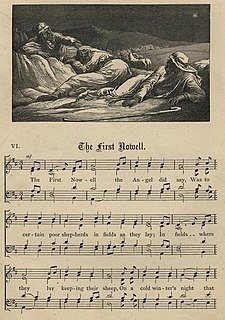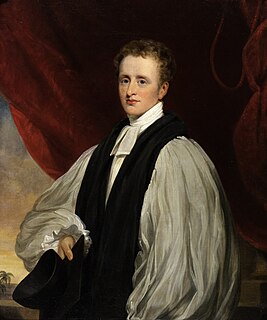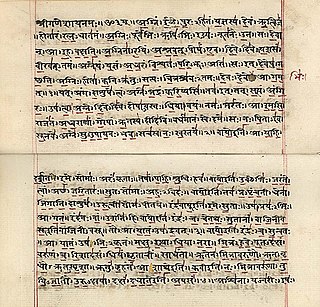
The "Battle Hymn of the Republic", also known as "Mine Eyes Have Seen the Glory" outside of the United States, is a lyric by the abolitionist writer Julia Ward Howe using the music from the song "John Brown's Body". Howe's more famous lyrics were written in November 1861 and first published in The Atlantic Monthly in February 1862. The song links the judgment of the wicked at the end of the age with the American Civil War. It is an extremely popular and well-known American patriotic song.

"Ave maris stella" is a Marian hymn used at Vespers from about the eighth century. It was especially popular in the Middle Ages and has been used by many composers as the basis of other compositions.

Finlandia, Op. 26, is a tone poem by the Finnish composer Jean Sibelius. It was written in 1899 and revised in 1900. The piece was composed for the Press Celebrations of 1899, a covert protest against increasing censorship from the Russian Empire, and was the last of seven pieces performed as an accompaniment to a tableau depicting episodes from Finnish history. The premiere was on 2 July 1900 in Helsinki with the Helsinki Philharmonic Society conducted by Robert Kajanus. A typical performance takes between 7½ and 9 minutes depending on how it is performed.

"The First Noel" is a traditional classical English Christmas carol, most likely from the early modern period, although possibly earlier. Noel is an Early Modern English synonym of "Christmas".

"O Come, All Ye Faithful" is a Christmas carol that has been attributed to various authors, including John Francis Wade (1711–1786), John Reading (1645–1692), King John IV of Portugal (1604–1656), and anonymous monks. The earliest printed version is in a book published by Wade, but the earliest manuscript bears the name of King John IV, and is located in the library of the Ducal Palace of Vila Viçosa. A manuscript by Wade, dating to 1751, is held by Stonyhurst College in Lancashire.

"Christ the Lord Is Risen Today" is a Christian hymn associated with Easter. Most of the stanzas were written by Charles Wesley, and the hymn appeared under the title "Hymn for Easter Day" in Hymns and Sacred Poems by Charles and John Wesley in 1739. The hymn eventually became well known for the "Alleluia" sung as a melisma after each line, which was added by an unknown author, probably to fit the commonly used hymn tune of "Easter hymn". It remains a traditional processional hymn on Easter Sunday.

"Abide with Me" is a Christian hymn by Scottish Anglican Henry Francis Lyte most often sung to English composer William Henry Monk's tune entitled Eventide. It was written in Crossabeg, County Wexford, Ireland, in Artramon House.

"Jesus Christ Is Risen Today" is a Christian hymn. It was initially written in the 14th century as a Bohemian Latin hymn titled "Surrexit Christus hodie". It is an Easter hymn referring to the Resurrection of Jesus and based on Matthew 28:6, Acts 2:32, 1 Peter 3:18 and Revelation 1:17-18.

"Eternal Father, Strong to Save" is a British hymn traditionally associated with seafarers, particularly in the maritime armed services. Written in 1860, its author William Whiting was inspired by the dangers of the sea described in Psalm 107. It was popularised by the Royal Navy and the United States Navy in the late 19th century, and variations of it were soon adopted by many branches of the armed services in the United Kingdom and the United States. Services who have adapted the hymn include the Royal Marines, Royal Air Force, the British Army, the US Coast Guard and the US Marine Corps, as well as the navies of many Commonwealth realms. Accordingly, it is known by many names, variously referred to as the Hymn of Her Majesty's Armed Forces, the Royal Navy Hymn, the United States Navy Hymn, and sometimes by the last line of its first verse, "For Those in Peril on the Sea". The hymn has a long tradition in civilian maritime contexts as well, being regularly invoked by ship's chaplains and sung during services on ocean crossings.

"Nearer, My God, to Thee" is a 19th-century Christian hymn by Sarah Flower Adams, which retells the story of Jacob's dream. Genesis 28:11–12 can be translated as follows: "So he came to a certain place and stayed there all night, because the sun had set. And he took one of the stones of that place and put it at his head, and he lay down in that place to sleep. Then he dreamed, and behold, a ladder was set up on the earth, and its top reached to heaven; and there the angels of God were ascending and descending on it..."

"The Old Rugged Cross" is a popular hymn written in 1912 by evangelist and song-leader George Bennard (1873–1958).

"We Gather Together" is a Christian hymn of Dutch origin written in 1597 by Adrianus Valerius as "Wilt heden nu treden" to celebrate the Dutch victory over Spanish forces in the Battle of Turnhout. It was originally set to a Dutch folk tune. In the United States, it is popularly associated with Thanksgiving Day and is often sung at family meals and at religious services on that day.

"Onward, Christian Soldiers" is a 19th-century English hymn. The words were written by Sabine Baring-Gould in 1865, and the music was composed by Arthur Sullivan in 1871. Sullivan named the tune "St Gertrude," after the wife of his friend Ernest Clay Ker Seymer, at whose country home he composed the tune. The Salvation Army adopted the hymn as its favoured processional. The piece became Sullivan's most popular hymn. The hymn's theme is taken from references in the New Testament to the Christian being a soldier for Christ, for example II Timothy 2:3 (KJV): "Thou therefore endure hardness, as a good soldier of Jesus Christ."

"Holy, Holy, Holy!" is a Christian hymn written by the Anglican bishop Reginald Heber (1783–1826). Its lyrics speak specifically of the Holy Trinity, having been written for use on Trinity Sunday. The opening line references Isaiah 6:3, Revelation 4:8 and mirrors the opening line of the Sanctus as found in the Book of Common Prayer. John Bacchus Dykes composed the tune Nicaea for this hymn in 1861. The tune name is a tribute to the First Council of Nicaea which formalized the doctrine of the Trinity in 325.

"Come, Ye Thankful People, Come" is an English Christian harvest festival hymn written in 1844 by Henry Alford. It is often sung to the tune St. George's, Windsor by George Job Elvey.

"Will the Circle Be Unbroken?" is a popular Christian hymn written in 1907 by Ada R. Habershon with music by Charles H. Gabriel. The song is often recorded unattributed and, because of its age, has lapsed into the public domain. Most of the chorus appears in the later songs "Can the Circle Be Unbroken" and "Daddy Sang Bass".

The Rigveda is an ancient Indian collection of Vedic Sanskrit hymns. It is one of the four sacred canonical texts (śruti) of Hinduism known as the Vedas.

"All Creatures of Our God and King" is an English Christian Easter hymn by William Henry Draper, based on a poem by St. Francis of Assisi. It was first published in a hymn book in 1919.

"Sun of Unclouded Righteousness" is a little-known 1758 Christian hymn written by Charles Wesley, the brother of John Wesley, the founder of Methodism. It was written as an intercessory hymn praying for the salvation of Muslims and calls for their conversion to Christianity. It had fallen out of use by around 1880.





















